The Carved Stone Ornament of the Mosque of al-Ḥākim
by Terry Allen
Full Table of Contents
Chapter Nine. Ornamented Inscriptions
The inscriptions of the Mosque of al-Ḥākim are part of its carved stone
ornament, although both Arabic script and its freely distributed
decoration
are inherently unlike the generally repeating patterns that make up most
of the mosque's ornament.
Some of the inscriptions
include foliate ornament growing from the letters, making Arabic
script here
another category of design (along with geometry) with which
foliate elements are integrated.
Below is a list of original
Fāṭimid carved stone inscriptions on the Mosque of al-Ḥākim.
On the main entrance, northeast side, at the southeast end, fragments
not in their original position, and unornamented (see
Chapter One, The Main Entrance Frieze and the Palmette Frieze of the Northern Minaret).
In the main entrance, at the back of the entrance passage,
on a plaque, naming al-Ḥākim
(lost, see Creswell, Muslim
Architecture of Egypt, v. 1, p. 71, with bibliography;
there is an 1838 engraving of it).
Above the entrance to the staircase of northern minaret,
ornamented with
a foliate stem running across what appears to be the entire
description
(Flury, op. cit., pl. 24, 1, same as
Creswell, Muslim
Architecture of Egypt, v. 1, fig. 33, pl. 23, a;
see also Flury, pl. 24, 3, same as Creswell,
pl. 23, d), about 1.3 m. wide.147
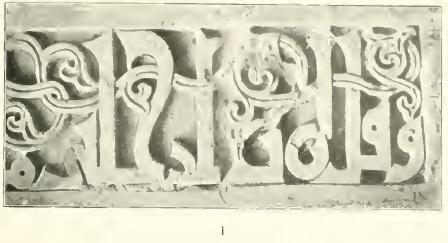 Figure 92. Inscription
above the entrance to the staircase of northern minaret;
Flury, Ornamente, pl. 24, 1.
|
On the socle of the northern minaret, a medallion
with the word Allāh, unornamented; see
“The Medallions of the Socle of the
Northern Minaret” and Figure 64.
In the surviving medallion of the second register of the
cylindrical section of the northern
minaret, a very lightly ornamented inscription in the circular frame
and an unornamented inscription in the center; see
“The Medallions of the Second Register of the Northern
Minaret” and
Figure 65.
In the frames of the blind windows of the third register
of the cylindrical section of the northern minaret.
For the unornamented inscriptions of the window facing north see
“The Screen of the Window Facing North” and
Figure 47; there are foliate forms in the
corners of the frame. For the window facing west see
“The Screen of the Window Facing West” and
Figure 48; this inscription is
lightly ornamented and shares the corner forms of the window
facing north.
In the fourth register of the
cylindrical section of the northern minaret,
a richly ornamented frieze naming al-Ḥākim
(Creswell, Muslim
Architecture of Egypt, v. 1, fig. 36; pl. 25, c, same as Flury, op. cit., pl.
29, 1;
Creswell, pl. 25, d, a better print of
Creswell Archive
negative
EA.CA.132; part of this section is shown in Flury, op. cit.,
pl. 29, 3).
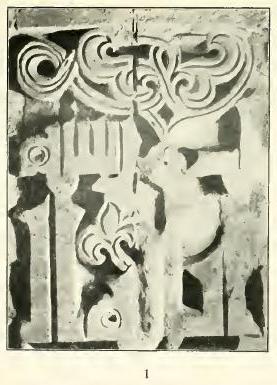 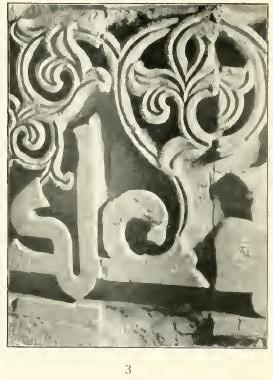
Figure 93. Northern minaret,
cylindrical section, inscription in fourth register; Flury, Ornamente, pl. 29,
1.
|
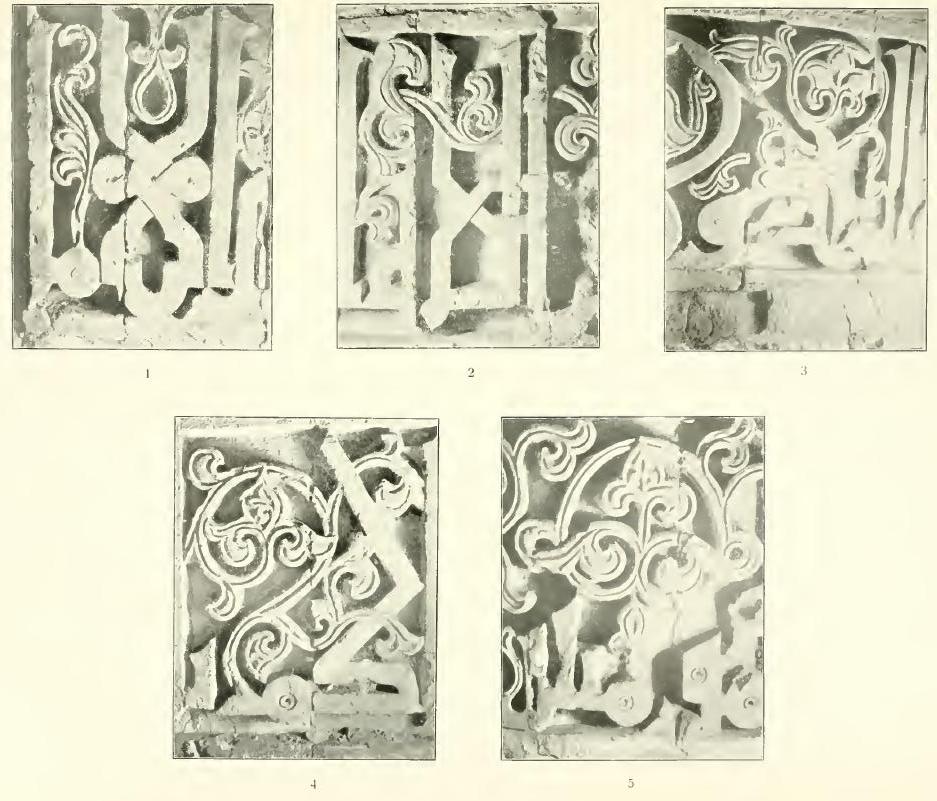 Figure 94.
Inscription in fourth register; Flury, Ornamente, pl. 28.
|
In the eighth register of the western minaret,
a lightly ornamented frieze 55 cm. high, naming al-Ḥākim; see
Creswell, Muslim
Architecture of Egypt, v. 1, fig. 40;
Creswell
Archive, negative EA.CA.120
(Creswell, Muslim
Architecture of Egypt, v. 1, pl. 29, a);
Flury, op. cit., pl. 32, 4 is an oblique view but not a good
one.148
In
the eleventh register of the western minaret,
a richly ornamented frieze 79 cm. high, naming al-Ḥākim
(see footnote above).
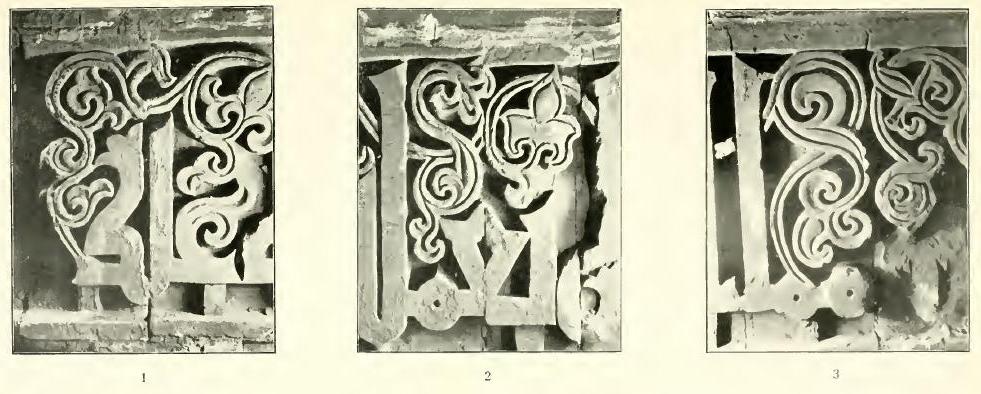 Figure 95. Western minaret,
inscription frieze of eleventh register; Flury, Ornamente, pl. 33,
1–3.
|
Flury's photographs are shown above; Creswell used others.
See
Creswell, Muslim
Architecture of Egypt, v. 1, fig. 40,
Creswell
Archive, negative EA.CA.3138
(Creswell, Muslim
Architecture of Egypt, v. 1, pl. 30, a),
EA.CA.3139, and
EA.CA.137
(Creswell, Muslim
Architecture of Egypt, v. 1, pl. 30, b, but cropped).
The following seem to be other views of the same frieze:
EA.CA.1637 (with the most ornament),
EA.CA.3140,
EA.CA.3141 (two views of the same section,
differently lit; the direction of slope of the handrail shows that
this is not the northern minaret),
and
EA.CA.3142 (with metal staircase).
A group of six limestone blocks in the Museum of Islamic Art,
Cairo, is said to have come from the Mosque of al-Ḥākim. Their ornament
appears to support that provenance and the text names
al-Ḥākim. They were first
published in 1903 and
their original location appears to be
unknown.149
Finally, the inscription on the exterior of the cubical
buttress constructed around the western minaret in 401/1010
may be considered.150
I am not an epigrapher and I am certain I am unaware of
some of the epigraphic literature on these inscriptions.
I am not concerned here with the style of the script,
but with its ornament, and specifically with whether that ornament
is related to the other carved stone ornament.
The lightly ornamented
inscriptions
in the medallion of the second register of the
cylindrical section of the northern minaret,
in the frame of the window
facing west in the third register of the same section,
and in the
frieze in the eighth register of the western minaret
offer little to analyze; the foliate ornament of the letters
in the frieze is hollowed out or slant-cut to develop internal
detail, unlike the letters,
while the foliate ornament of the other inscriptions
is as flat as their letters. There is nothing much to link
this ornament with the rest of the carved stone ornament.
The inscription on the exterior of the cubical
buttress constructed around the western minaret
resembles not the original stone ornament, but the stucco
of the antemihrab dome: both have foliate forms not seen
in the original stone ornament and particularly
in the stucco these forms are distinctively
articulated or enlivened with groups of small round
holes.151
 Figure 96. Stucco inscriptions below antemihrab
dome; Flury,
Ornamente,
pl. 2
(cf.
Creswell, Muslim Architecture of Egypt, pl. 109, a, b).
|
The remaining inscriptions and those of the interior (of which more
later), as well as stucco inscriptions in the Mosque of al-Azhar,
have a prominent place in the discussion of so-called foliated
Kūfic (coufique fleuri,
Blumenkūfī),
which Flury and Adolf Grohmann consider first to have been developed
fully in Cairo and in these very
monuments.152
Whatever the priority of Cairo in the development of a style
of epigraphy that became widespread in the Islamic world,
Kūfic with stems and foliation attached clearly did not
come from Spain.
As few photographs, so far as I know, have been published of
the tall inscription friezes of the two minarets
my conclusions from the material at hand
must remain tentative. I think it clear that, like the
entrance to the staircase of the northern minaret and
the six loose limestone blocks,
its foliate ornament is entirely consonant
with that of the nonepigraphic ornament.
While Flury's photograph of the inscription
above the entrance to the staircase of
the northern minaret shows perhaps more than half of it,
the section published shows only a single leaf form, on a grooved
stem, but that leaf is familiar from the material already
discussed.
All of the leaf forms in the group of six limestone blocks in
the Museum of Islamic Art are found in the nonepigraphic ornament,
and one, at the left of the top row in Grohmann's illustrations
(no. 2638?) has a grooved ringed stem that splits at a small pointed
oval, then splits again on both sides, very much like the element
in the bottom right loop of the northwestern niche head on the
main entrance (see Figure 63).
The ornament of the inscription frieze of the fourth register
of the cylindrical section of the northern minaret is more
elaborate than that of, say, the window frames in seventh register
of that minaret: the grooved stems occasionally vary in width,
and a few leaves have more internal detail, but they otherwise
they are rendered in the same way, with grooved outlining and
occasional hollowing out. The especially noticeable five-lobed
leaf in the upper right of Flury's pl. 28, 3
(Figure 94) is paralleled in the
more crudely carved elements flanking the center of the top of
the window facing east (see Figure 32).
The split palmettes in which the two tops form stems curving
across each other
(Figure 93) are absolutely typical
of the carved stone ornament of the mosque; one of the two sets of
vertical axes of the main entrance frieze (Figure 1) is marked by such elements.
The inscription frieze in the eleventh register of the western
minaret seems to me quite similar, sharing variation in the width of
the grooved stems and the same five-lobed leaf, although in the
details published there is not so much internal detail.
I do not see how to separate the ornament of these original,
richly decorated inscriptions
from the bulk of the foliate carved stone ornament. It is
from the same craft tradition and distinct from that of the
stucco and the slightly later inscription on the exterior of the
buttress of the western minaret, so I conclude that it was all
executed by members of the same group of stonecutters, of whom
I imagine the calligrapher was not one.
Now while I would expect the foliate ornament of these inscriptions to
have been designed by the calligrapher, it may not have been so:
the calligrapher may have provided only the letters, or
he may have indicated the layout of the ornament but
not its details, or the man carving the inscription may have
substituted his own familiar motifs for those indicated
by the calligrapher. Perhaps most plausibly, the stonework
designer collaborated with the calligrapher (which is likely
in any case for the laying out of the inscription if not its
enlargement from a smaller-scale original). Such an arrangement
would not have required the stonecarvers to execute unfamiliar
foliate
forms, which they might not have been expected to do well.
It might prove interesting to find other cases in which
the ornament of architectural inscriptions can be compared with
contemporary but nonepigraphic ornament from the same monument.
147. Width
inferred from Creswell, Muslim
Architecture of Egypt, v. 1, fig. 33.
148. The reference in Flury's text, p. 48,
where the measurement is given,
is to the wrong plate. Adolf Grohmann,
“The Origin and Early Development of
Floriated Kūfic”,
Ars Orientalis, v. 2, 1957,
pp. 183–213, fig. 25 on pl. 10, is a shorter length of the
same section, from a different photograph, localized in the
“seventh band” in the caption because Creswell
bobbled his description of the inscription (never actually
using the word “eighth”, Muslim
Architecture of Egypt, v. 1, p. 96).
149. For the first
publications see
Bloom, op. cit., p. 35, no. 11. I have used the photographs
in Adolf Grohmann,
Arabische Paläographie
(Österreichische Akademie
der Wissenschaften, Philosophisch-historische Klasse,
Denkschriften, v. 94), 2 v.,
Vienna, 1971, v. 2, pl. 24, 1; they also appear in Grohmann,
“The Origin and Early Development of
Floriated Kūfic”,
pp. 183–213, fig. 20 on pl. 7.
For their localization see Bloom, op. cit., p. 19, speculating that they
may have come from the main entrance, which is likely considering
the date of restoration work there.
150. Creswell, op. cit., v. 1,
p. 90, citing al-Maqrīzī; pl. 27, d.
151. There were also some
remains of a stucco inscription below the springing of squinch of
the dome in the south corner of the original prayer hall,
ibid., pl. 109, c.
152. For the contents of the
inscriptions see the appendix to Bloom,
“The Mosque of al-Ḥākim in Cairo”.
For “foliated Kūfic” see
Flury, Ornamente and for
al-Azhar
“Le décor épigraphique des
monuments fatimides du Caire”; Grohmann,
“The Origin and Early Development of
Floriated Kūfic”, pp. 207–13, and
Arabische Paläographie,
v. 2, pp. 139–40. The term “foliated Kūfic”
is poorly chosen: while flowers appear later,
in these inscriptions, anyway,
what grows from letters and stems
is leaves, rarely or never flowers.





